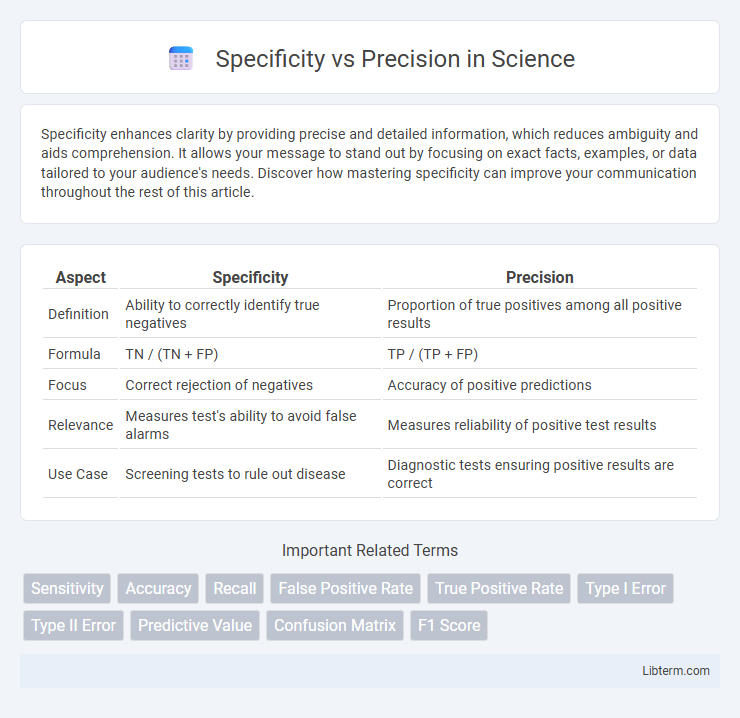Specificity enhances clarity by providing precise and detailed information, which reduces ambiguity and aids comprehension. It allows your message to stand out by focusing on exact facts, examples, or data tailored to your audience's needs. Discover how mastering specificity can improve your communication throughout the rest of this article.
Table of Comparison
| Aspect | Specificity | Precision |
|---|---|---|
| Definition | Ability to correctly identify true negatives | Proportion of true positives among all positive results |
| Formula | TN / (TN + FP) | TP / (TP + FP) |
| Focus | Correct rejection of negatives | Accuracy of positive predictions |
| Relevance | Measures test's ability to avoid false alarms | Measures reliability of positive test results |
| Use Case | Screening tests to rule out disease | Diagnostic tests ensuring positive results are correct |
Understanding Specificity and Precision
Specificity measures a test's ability to correctly identify true negatives, reflecting how well it excludes non-target conditions. Precision, or positive predictive value, quantifies the proportion of true positive results among all positive test outcomes, emphasizing result accuracy. Understanding specificity and precision is crucial for evaluating diagnostic tests and machine learning models to balance false positives and confirm reliable predictions.
Defining Specificity in Context
Specificity refers to the ability of a test or model to correctly identify negative cases, quantifying the proportion of true negatives accurately recognized. It is a crucial metric in fields like medical diagnostics and machine learning, where distinguishing negatives reduces false positive rates, thereby improving overall reliability. High specificity ensures that non-target instances are effectively excluded, enhancing the accuracy of classification systems.
What Does Precision Mean?
Precision refers to the consistency and exactness of repeated measurements or results within a dataset, indicating how closely data points cluster together. It quantifies the reproducibility of outcomes regardless of their accuracy or closeness to the true value. High precision means reduced variability and narrow dispersion among data, critical in scientific experiments and machine learning model evaluations.
Key Differences Between Specificity and Precision
Specificity measures the ability of a test to correctly identify true negatives, indicating how well it excludes non-target cases, while precision focuses on the proportion of true positive results among all positive predictions made, emphasizing the accuracy of positive identifications. Specificity is crucial in contexts where minimizing false positives is important, such as medical diagnoses, whereas precision is vital in applications like information retrieval where the relevance of positive results must be ensured. Both metrics address different aspects of classification performance, with specificity relating to negative class exclusion and precision relating to positive class correctness.
Importance in Scientific Research
Specificity measures the ability of a test to correctly identify true negatives, while precision evaluates the consistency and repeatability of measurements in scientific research. High specificity is crucial in minimizing false positives, ensuring that the findings accurately reflect the absence of an effect or condition. Precision enhances the reliability of experimental results, facilitating reproducibility and confidence in scientific conclusions.
Implications in Data Analysis
In data analysis, specificity measures the ability to correctly identify true negatives, while precision focuses on correctly identifying true positives among positive predictions. High specificity reduces false positive rates, critical in scenarios like medical diagnostics where avoiding misdiagnosis is essential. Precision directly impacts the reliability of positive predictive outcomes, making both metrics vital for comprehensive model evaluation and decision-making.
Role in Machine Learning Models
Specificity measures a machine learning model's ability to correctly identify negative instances, minimizing false positives, which is crucial in applications like medical diagnostics where false alarms can cause unnecessary treatments. Precision quantifies how many positively predicted cases are actually positive, ensuring trust in positive predictions, especially important in fraud detection to avoid falsely accusing users. Balancing specificity and precision helps optimize model performance by reducing type I errors and increasing the reliability of positive classifications in classification tasks.
Applications in Medical Diagnostics
Specificity measures a medical test's ability to correctly identify patients without a disease, minimizing false positives, while precision quantifies how many positive test results are true positives, emphasizing result reliability. High specificity is crucial in screening to avoid unnecessary treatments, whereas high precision ensures that positive diagnoses are trustworthy for clinical decision-making. Applications in cancer screening and infectious disease diagnostics highlight the balance between specificity and precision to optimize patient outcomes and resource allocation.
Common Misconceptions Clarified
Specificity measures the proportion of true negatives correctly identified, whereas precision focuses on the proportion of true positives among all positive predictions. A common misconception is that both metrics assess the accuracy of positive results, but specificity actually evaluates the ability to exclude false positives. Clarifying this distinction helps improve the interpretation of classification model performance, especially in imbalanced datasets.
Choosing Between Specificity and Precision
Choosing between specificity and precision depends on the context of the task, with specificity emphasizing the correct identification of true negatives and precision focusing on the accuracy of positive predictions. In medical diagnostics, high specificity reduces false positives to avoid unnecessary treatments, while high precision ensures that positive results represent actual cases, minimizing misdiagnosis. Balancing these metrics requires understanding the consequences of false positives versus false negatives in the specific application to optimize decision-making.
Specificity Infographic

 libterm.com
libterm.com